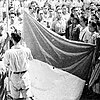|
Police actions (Indonesia)
The police actions (Dutch: Politionele acties, also politiële acties),[1] were two major military offensives that the Netherlands carried out on Java and Sumatra against the Republic of Indonesia during its struggle for independence in the Indonesian National Revolution.[2][3] In Indonesia they are collectively known as the Dutch Military Aggressions (Indonesian: Agresi Militer Belanda), although the less common translation Aksi Polisionil is also used. In Dutch historiography and discourse, the entire Indonesian War of Independence was for a long time euphemistically referred to as 'the police actions', as coined by the government of the time. In the Netherlands, the impression prevailed that there had only been two separate, short-lived police actions, intended to restore Dutch authority over a rebellious overseas territory. This perspective ignores the fact that between the arrival of Dutch troops in March 1946 and the cession of sovereignty in December 1949, there had been a full-scale military occupation and an ongoing counterinsurgency involving 120,000 conscripts.[4] Operation ProductOperation Product took place between 21 July and 5 August 1947.[2] The Dutch greatly reduced and fragmented Indonesian-controlled territories, with a particular focus on the oil fields and rubber plantations of Sumatra, and the sugar plantations and economic infrastructure of Java.[5] The offensive excluded an attack on the city of Yogyakarta, wartime seat of the Republican government, due to high expected costs of urban warfare. The actions of the Mariniersbrigade on Java were further divided into an amphibious landing on Pasir Putih, East Java (Product North), amphibious operations in the Meneng Bay (Product East), and a southward offensive launched from Porong (Product South).[6] Operation KraaiOperation Kraai (Operation Crow) took place between 19 December 1948 and 5 January 1949.[7] It resulted in the Dutch capture of Yogyakarta, the arrests of much of the Indonesian leadership, and the exile of what remained of the Republican government to Sumatra.[5] Actions of the Mariniersbrigade on East Java during this offensive are referred to as Operation Zeemeeuw (Operation Seagull).[6] Other operationsEclipsed by the scale and notoriety of Product and Kraai, other Dutch offensive operations of the Indonesian Revolution include:[6][8]
See also
References
Further readingWikimedia Commons has media related to Politionele acties (Dutch East Indies).
|

